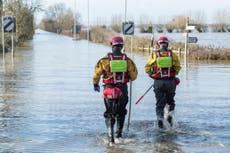What is the official advice on driving in flood water?
UK hammered with heavy rain throughout November, sparking transport chaos
The UK has been hit by torrential downpours throughout November and more wet weather appears to be on the way as we venture further into autumn.
Britain has already seen drivers forced to contend with deep flood waters washing onto roads and causing traffic chaos, notably near Shermanbury in West Sussex when “around 20 cars” had to be abandoned on the A27 on Wednesday after the River Adur burst its banks, according to the region’s fire and rescue service.
There were further road closures across the south of England and trains were delayed or cancelled between London Victoria and Southampton and on routes in and around Brighton before the wet weather began to move north through Birmingham towards northern Wales, Liverpool, Manchester and Hull.
Cars were subsequently caught up in flood water in eastern Scotland too, including along the A92 between Fife and Dundee and the A935 road between Brechin and Montrose.
With the Environment Agency and Met Office issuing weather warnings over the heavy rain and associated threat of flooding, RAC breakdown spokesman Rod Dennis warned drivers to “exercise great care” when venturing out in downpours.
“The chances of being involved in a collision rise dramatically in wet weather, and even more so if there’s snow, so it’s vital drivers slow down, leave plenty of space behind the vehicle in front and use their lights to make sure they’re easily seen by other road users,” he said.
“The risk of aquaplaning where a vehicle’s wheels lose contact with the road as they skim across standing water will be high, particularly for those who don’t slow down to appropriate speeds for the conditions.”
The AA’s advice regarding driving through flood water is to size up the reality of the situation and the depth of the swell before even attempting it, avoid standing water whenever possible and never to venture into water that is “moving or more than 10cm deep”.
The association points out that just 30cm of moving water is enough to move your vehicle and 60cm of standing water is enough to float it.
It suggests that, if you do attempt to cross a flooded road, allow approaching cars to pass first, drive slowly to avoid losing contact with the tarmac (and therefore control) and to prevent bow waves or soaking pedestrians.

You should also test your brakes as soon as you emerge onto a dry surface, creating friction and therefore heat to evaporate away excess moisture, and be alert to possible mechanical faults because “it only takes an egg cupful of water to be sucked into your engine to wreck it”.
If you do get stuck in flood water, you should stay calm and be prepared to stay put.
“It’s usually best to wait in the car and call for help rather than try to get out,” according to the AA.
This is not just because of the obvious and immediate dangers of deep, cold or moving water but because of the health threats posed by water contaminated by overrunning drains or agricultural chemical runoff.
On breaking down in adverse conditions, the RAC adds: “If your engine cuts out after driving through deep water, do not attempt to restart it, as engine damage may occur – instead, turn on the hazard lights, call for assistance and have the vehicle professionally examined.”
If you are forced to abandon your car on the roadside and have it rescued, you are advised to have it checked out by a mechanic or breakdown technician before restarting in case of water damage.
Join our commenting forum
Join thought-provoking conversations, follow other Independent readers and see their replies
Comments


Bookmark popover
Removed from bookmarks